Perugia
[In which showcase are the following ??]
Funerary Vase (ca. 450 BC)
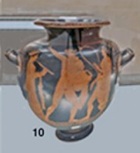
Situla (ca. 400 BC)
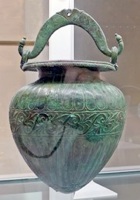
Etruscan Mirror (ca. 330 BC)

San Martino in Campo
Urn (9th century BC)
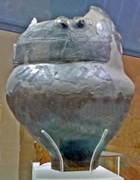
Castiglione del Lago
Grave Goods from Villastrada (date ?)
[Showcase 7]
Helmet from the Ipogeo dei Tetina (late 4th or 3rd century BC)
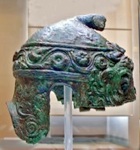
Magione
A bronze votive offering (early 2nd century BC) known as the Graziani putto, which depicted a naked baby boy, was found in 1587 at Sanguinetto on Lake Trasimeno. An Etruscan inscription recorded that it was offered "to the god Tec Sans as a gift": Tec Sans, was a local deity that protected children. This object is exhibited in the Museo Gregoriano Etrusco, Vatican, Rome). A number of the votive offerings from nearby Magione that are exhibited in showcase 11 also depict babies, and were thus presumably also offerings to Tec Sans.
Votive offerings from Colle Arsiccio (5th – 1st centuries BC)
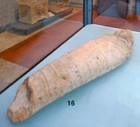
Votive offerings from Pasticcetto (5th – 3rd centuries BC)
Excavations in 1984 unearthed the base of a temple at Pasticcetto di Magione, together with a deposit of some 600 bronze votive offerings. The majority of these represented full-length human figures (either deities or offerants) or animals. [Is the collection displayed ?]
Votive deposits from Caligiana (3rd - 1st centuries BC)

Settevalli
Tempio di San Faustino

The exhibit at the end of the room represents the tympanum of a temple that was discovered in 1962 in Via Piccolpasso, some 5 km south west of Perugia. The damaged antefix that seems to have come from the centre of the tympanum depicts (probably) a satyr supporting the drunken Dionysus. This and the other antefixes probably date to the 2nd century BC.
The antefixes were probably associated with the monumentalisation of a much older cult site. Evidence for this hypothesis comes from a number of votive bronzes (6th - 4th centuries) that were found in a deposit on the site (exhibited showcase 11). The figures include:
-
✴two female figures that probably all date to the 5th century BC:
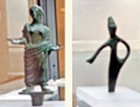
-
•a praying woman; and
-
•a female offerant or goddess (similar to a number of figures from Pasticcetto di Magione - see below);
-
✴and a (probably) later figure of a naked baby boy similar to the Graziani putto (see Magione above).
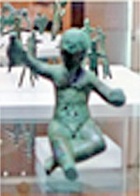
Return to the main page on the Sala dei Bronzi
Return to the main page on the Museo Archeologico



